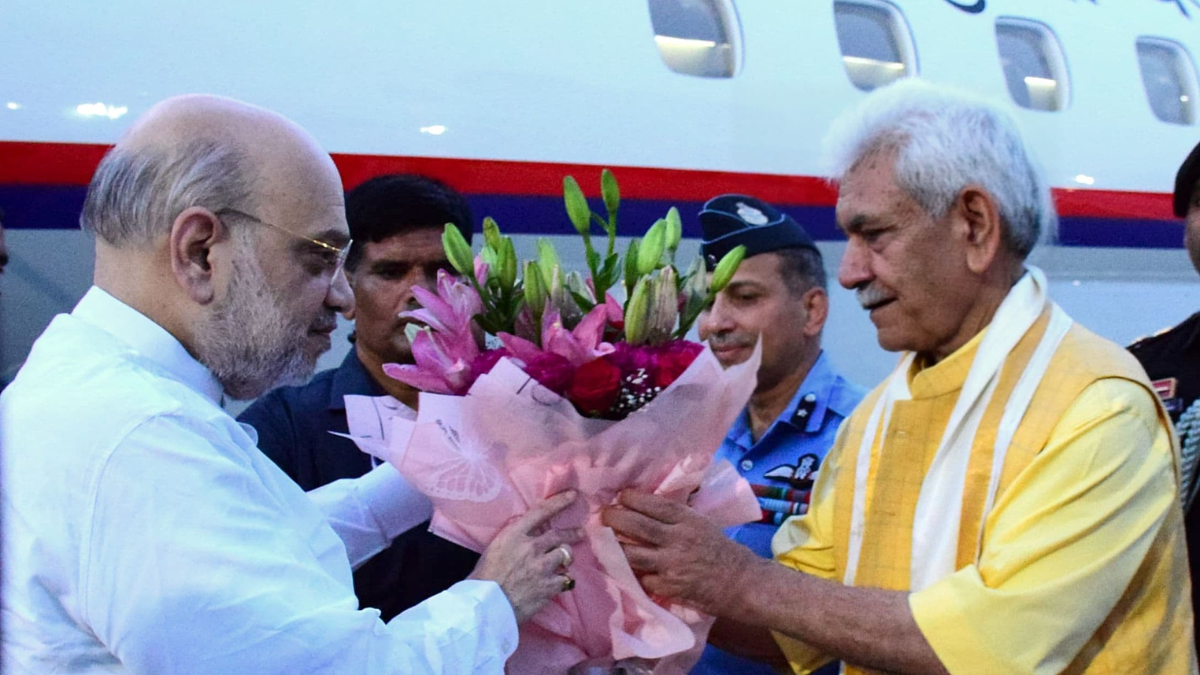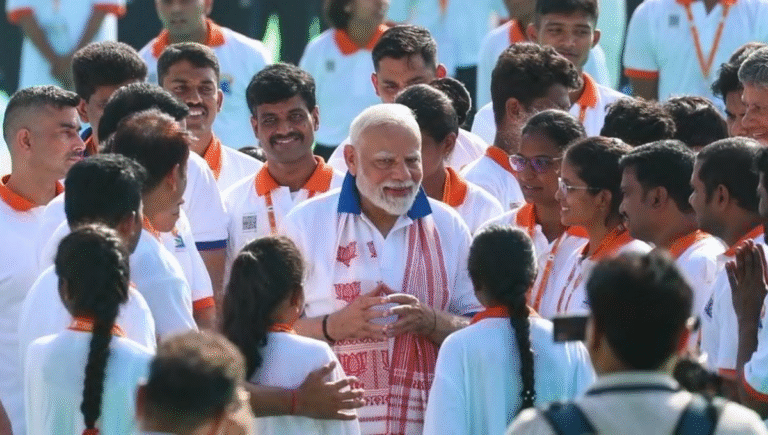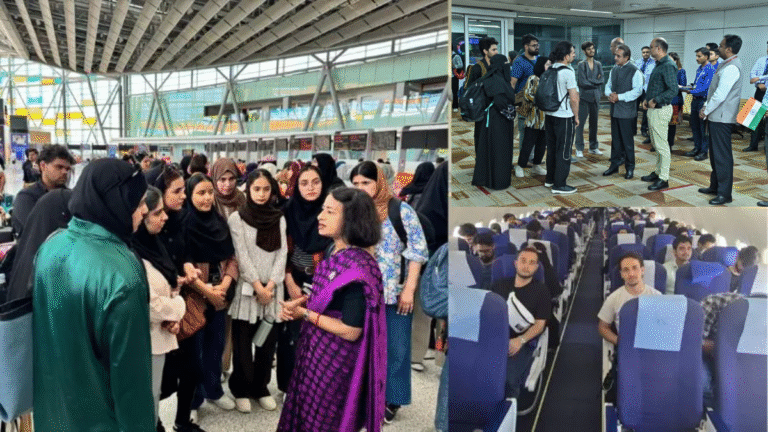Kashmir unrest root cause Amit Shah: Union Home Minister Amit Shah has once again ignited a national debate over Kashmir’s long-standing unrest. In a detailed conversation with The Economic Times, Shah attributed the large-scale arming of Kashmiri youth to the elections conducted by Indira Gandhi in the 1980s. This, he says, was a key turning point in the Valley’s descent into militancy. Amid the backdrop of the deadly April 22 Pahalgam terror attack that killed 26 people, Shah’s remarks come as part of a broader narrative from the government to address not just terrorism but also its root causes in Kashmir.
With ongoing counter-terrorism operations like Operation Sindoor and the government’s push for development and integration post-Article 370 abrogation, Shah’s statements give an insight into how New Delhi is reframing its strategy in the region.
Kashmir unrest root cause Amit Shah: Amit Shah Links Kashmir Militancy to Indira Gandhi-Era Elections
According to Home Minister Amit Shah, a detailed government probe following the April 22 terror attack in Pahalgam brought forth one of the most significant revelations: that the largest number of Kashmiri youths took up arms following the elections overseen by then Prime Minister Indira Gandhi. Shah claimed that these elections led to disenchantment and disillusionment among Kashmir’s younger population, who then became vulnerable to separatist ideologies and militant recruitment.

This new line of reasoning puts a historic and political lens on the Valley’s security situation, contrasting earlier narratives that largely focused on Pakistan’s involvement through the ISI and military. While not denying Islamabad’s provocation, Shah emphasized that the underlying issue lay within how Kashmir’s internal political framework evolved during that period.
Post-Article 370 Era: A Shift in the Valley’s Political Landscape
Shah underlined that the abrogation of Article 370 was a decisive step in closing a decades-old chapter that fed into separatist ideologies. He mentioned that Article 370 had allowed a narrative to flourish—that Jammu & Kashmir needed independence or a special status. Its removal, therefore, was not merely a constitutional change but a psychological one aimed at national integration.
Since then, Shah claimed, democratic processes have deepened in the region. Unlike earlier times when a few political families monopolized power, recent elections have seen fresh grassroots participation. Over 19,000 young people have now become sarpanches, zila adhyaksh, and MLAs, reshaping the power dynamics of Jammu & Kashmir. The Home Minister described this as the beginning of a new democratic chapter in the Valley.
अंतरराष्ट्रीय सहकारिता वर्ष के उपलक्ष्य में NAFED द्वारा आयोजित राष्ट्रीय संगोष्ठी से लाइव…
— Amit Shah (@AmitShah) June 20, 2025
आंतरराष्ट्रीय सहकार वर्षाच्या निमित्ताने NAFED द्वारा आयोजित परिसंवादातून लाईव्ह… https://t.co/ZQnkg0icFD
Operation Sindoor and India’s Zero-Tolerance Policy on Terrorism
While acknowledging the surge in cross-border terror activity, especially after the recent Pahalgam incident, Shah stressed that India’s zero-tolerance policy against terrorism remains unshaken. He described Operation Sindoor as a robust and ongoing effort to eliminate all forms of terrorism, not just targeting individual figures but eradicating the broader ecosystem that sustains militancy.
Shah also noted that many of the terrorists eliminated during Operation Sindoor were linked to high-profile attacks in India, including the Mumbai terror attacks. “Our fight is not against any one individual, it’s against all terrorism,” he said. The operation is still active, and intelligence agencies are currently assessing how many foreign terrorists may have slipped in during the chaos. He stated that a strong and fitting response to Pakistan is underway and will intensify depending on further provocations.
Development as a Long-Term Counter to Terrorism
The Home Minister didn’t just focus on military strategy. He painted a picture of unprecedented development in Kashmir since 2014. According to Shah, 100% saturation has been achieved in all central welfare schemes in the Valley, with most villages now connected through proper road networks and regular electricity supply.
Iconic infrastructure projects like the Chenab Bridge are progressing steadily, and tourism in Kashmir had begun to see a major revival before the recent attack. Shah assured that the setback to tourism due to the Pahalgam incident is temporary and expressed confidence that peace and normalcy will return to the region within a year or two.
This infrastructure and social welfare boost is seen by the government as a long-term solution to root out the influence of radical ideologies. By integrating Kashmir into India’s economic and social mainstream, the Centre believes it can offer the youth of the Valley a future of hope, stability, and opportunity.
India’s Strategy in Terror-Prone Regions Beyond Kashmir
Amit Shah also expanded on the government’s broader counter-insurgency approach, stating that their goal is to understand and tackle the root causes of unrest not just in Kashmir, but also in other troubled regions like the Naxal-affected areas and the Northeast. The objective, he said, is not just military containment but psychological and political integration.
In these regions too, welfare schemes, infrastructure development, and employment opportunities have played a critical role in reducing the recruitment base for insurgent groups. According to Shah, the same holistic model is being applied in Jammu and Kashmir with considerable success.
Conclusion
Amit Shah’s latest remarks offer a layered understanding of the Kashmir issue—one that blends historical introspection with current policy direction. By holding the elections conducted during Indira Gandhi’s tenure responsible for the rise in Kashmiri militancy, the Home Minister has shifted part of the blame from external forces to internal political missteps.
His emphasis on Article 370’s removal as a game-changer, the success of grassroots democracy, and the large-scale developmental projects presents the narrative that Kashmir is on a path to recovery and normalization. However, with recent terror attacks like the one in Pahalgam, the challenge is far from over.
The government’s strategy appears to be two-fold: an iron hand against terrorism through operations like Sindoor and a velvet glove of development and inclusion for the people. Whether this combination will yield lasting peace remains to be seen, but for now, the Valley is at a pivotal juncture in its history—one shaped as much by its past as it is by its future.
For more such detailed and balanced coverage, stay connected with Taaza Wire—your fresh source of impactful news.
Also Read:
Operation Sindhu: Inside India’s High-Stakes Rescue from Iran Amid Israel-Iran War Tensions




[…] Amit Shah Blames 1980s Elections Under Indira Gandhi for Rise in Kashmir Militancy, Highlights Progr… […]